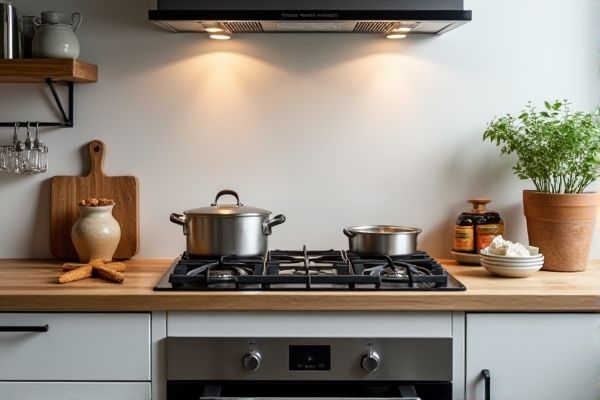
A cooktop is a built-in cooking surface integrated into your countertop, offering flexibility in kitchen design, while a rangetop resembles a stove's top section with professional-style burners typically installed within custom cabinetry. Explore the differences between cooktops and rangetops to determine which option best suits your cooking style and kitchen layout.
Table of Comparison
| Feature | Cooktop | Rangetop |
|---|---|---|
| Definition | Built-in appliance with burners, installed flush into the countertop. | Freestanding appliance with open burners, resembling a stove without an oven. |
| Installation | Requires cutout in countertop, integrates seamlessly. | Freestanding or built into cabinetry, larger and more prominent. |
| Burner Design | Typically enclosed burners. | Exposed, powerful burners with heavy-duty grates. |
| Size | Compact and space-efficient. | Larger footprint, designed for professional cooking. |
| Cooking Power | Standard cooking power, suitable for most kitchens. | Higher BTU output for faster and more precise cooking. |
| Price Range | Generally more affordable. | Premium pricing due to advanced performance. |
| Maintenance | Easier to clean, fewer parts exposed. | Requires more cleaning due to exposed burners and grates. |
| Design Impact | Minimalist look, blends with the countertop. | Bold, statement appliance enhancing kitchen aesthetic. |
Introduction to Cooktops and Rangetops
Cooktops are countertop cooking appliances featuring built-in burners, designed for flexible kitchen installation and often integrated into kitchen islands or countertops. Rangetops combine the functionality of both cooktops and ovens but are typically installed into cabinetry, providing professional-grade burners with high heat output for your culinary needs. Understanding the design and placement differences helps you choose the option that best suits your kitchen layout and cooking style.
Key Differences Between Cooktops and Rangetops
Cooktops are built-in cooking surfaces installed flush with kitchen countertops, offering a streamlined look and flexibility in kitchen layout, while rangetops are professional-style, freestanding units that combine a cooktop with an oven beneath for integrated cooking functionality. Rangetops typically feature larger burners with higher BTU output, catering to serious cooking needs, whereas cooktops provide varied burner sizes and styles, including gas, electric, and induction options. The key differences include cooktops' installation versatility and space efficiency versus rangetops' powerful performance and combination of stovetop and oven in a single appliance.
Design and Installation Considerations
Cooktops offer a sleek, built-in design that fits flush with countertops, providing flexibility in kitchen layout and easy integration with various cabinetry styles. Rangetops feature a professional, freestanding design requiring dedicated space and ventilation, often demanding custom installation to accommodate their larger size and heavy-duty components. Installation for cooktops typically involves cutting a countertop opening and connecting to existing utilities, while rangetops require reinforced support, precise gas or electric hookups, and compliance with local building codes.
Performance and Cooking Power
Cooktops offer precise temperature control with individual burners, providing consistent cooking power ideal for various culinary techniques. Rangetops deliver superior performance through professional-grade burners and higher BTU output, ensuring rapid heat-up times and efficient heat distribution. Both appliances excel in cooking power, but rangetops are preferred in commercial kitchens for intense, high-heat cooking demands.
Control and Burner Placement
Cooktops offer versatile control options with front or side-mounted knobs, providing easy access and precise flame adjustments for your cooking needs. Rangetops are designed with professional-style controls typically located at the front, allowing chefs to manage multiple burners simultaneously with enhanced accuracy. Burner placement on cooktops is often spaced for everyday cookware, while rangetops feature strategic burner layouts that accommodate various pot sizes and cooking techniques.
Space and Kitchen Layout Impact
Cooktops offer greater flexibility in kitchen layout design by being installed flush within countertops, maximizing counter space and allowing for customized cabinet arrangements. Rangetops, with their larger, freestanding design, often require dedicated hoods and more surrounding clearance, impacting the overall kitchen footprint and limiting cabinet placement options. Choosing between cooktop and rangetop directly influences kitchen workspace efficiency and spatial planning in modern kitchen designs.
Safety Features Comparison
Cooktops often include built-in safety features such as automatic shut-off, child lock controls, and residual heat indicators, enhancing user protection during cooking. Rangetops, designed for professional-style kitchens, may offer advanced flame failure devices and knob safety locks but generally lack the extensive electronic safety systems found in modern cooktops. Your choice should consider the balance between traditional control and innovative safety technology to best suit your kitchen environment.
Maintenance and Cleaning
Cooktops typically feature a flat, smooth surface that simplifies maintenance and cleaning, making it easy to wipe away spills and food debris. Rangetops, with their exposed burners and grates, require more detailed cleaning efforts to remove grease and food particles from crevices. Choosing your cooking appliance depends on how much time you're willing to invest in upkeep and ensuring your kitchen stays spotless.
Cost and Value Factors
Cooktops generally offer a lower upfront cost compared to rangetops, making them a budget-friendly option for homeowners seeking efficient cooking appliances. Rangetops, with their higher price point, provide professional-grade performance and durability that can enhance kitchen functionality and long-term value. Your decision between the two should consider not only initial expenses but also installation complexity, maintenance needs, and desired cooking experience.
Choosing the Right Option for Your Kitchen
Cooktops offer versatile installation options and are often more affordable, making them ideal for smaller kitchens or when replacing existing units without modifying cabinetry. Rangetops provide a premium, professional appearance with powerful burners and seamless integration, suited for larger kitchens and serious cooking enthusiasts who value performance and style. Consider your kitchen layout, cooking habits, and budget to choose between the compact efficiency of cooktops and the high-end functionality of rangetops.
 homyna.com
homyna.com